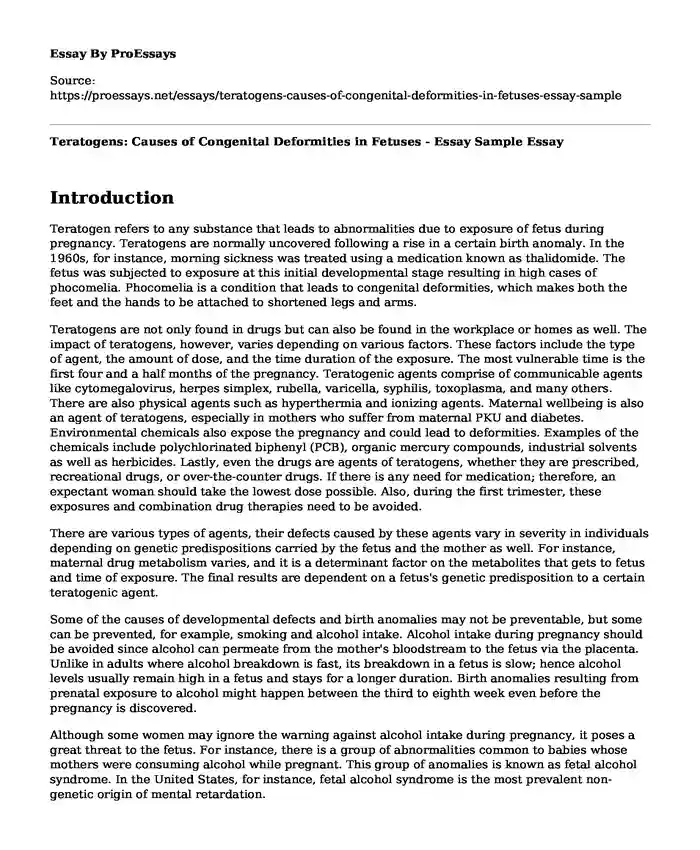Introduction
Teratogen refers to any substance that leads to abnormalities due to exposure of fetus during pregnancy. Teratogens are normally uncovered following a rise in a certain birth anomaly. In the 1960s, for instance, morning sickness was treated using a medication known as thalidomide. The fetus was subjected to exposure at this initial developmental stage resulting in high cases of phocomelia. Phocomelia is a condition that leads to congenital deformities, which makes both the feet and the hands to be attached to shortened legs and arms.
Teratogens are not only found in drugs but can also be found in the workplace or homes as well. The impact of teratogens, however, varies depending on various factors. These factors include the type of agent, the amount of dose, and the time duration of the exposure. The most vulnerable time is the first four and a half months of the pregnancy. Teratogenic agents comprise of communicable agents like cytomegalovirus, herpes simplex, rubella, varicella, syphilis, toxoplasma, and many others. There are also physical agents such as hyperthermia and ionizing agents. Maternal wellbeing is also an agent of teratogens, especially in mothers who suffer from maternal PKU and diabetes. Environmental chemicals also expose the pregnancy and could lead to deformities. Examples of the chemicals include polychlorinated biphenyl (PCB), organic mercury compounds, industrial solvents as well as herbicides. Lastly, even the drugs are agents of teratogens, whether they are prescribed, recreational drugs, or over-the-counter drugs. If there is any need for medication; therefore, an expectant woman should take the lowest dose possible. Also, during the first trimester, these exposures and combination drug therapies need to be avoided.
There are various types of agents, their defects caused by these agents vary in severity in individuals depending on genetic predispositions carried by the fetus and the mother as well. For instance, maternal drug metabolism varies, and it is a determinant factor on the metabolites that gets to fetus and time of exposure. The final results are dependent on a fetus's genetic predisposition to a certain teratogenic agent.
Some of the causes of developmental defects and birth anomalies may not be preventable, but some can be prevented, for example, smoking and alcohol intake. Alcohol intake during pregnancy should be avoided since alcohol can permeate from the mother's bloodstream to the fetus via the placenta. Unlike in adults where alcohol breakdown is fast, its breakdown in a fetus is slow; hence alcohol levels usually remain high in a fetus and stays for a longer duration. Birth anomalies resulting from prenatal exposure to alcohol might happen between the third to eighth week even before the pregnancy is discovered.
Although some women may ignore the warning against alcohol intake during pregnancy, it poses a great threat to the fetus. For instance, there is a group of abnormalities common to babies whose mothers were consuming alcohol while pregnant. This group of anomalies is known as fetal alcohol syndrome. In the United States, for instance, fetal alcohol syndrome is the most prevalent non-genetic origin of mental retardation.
Smoking, just like alcohol intake, is a threat to the normal development of the fetus. There are, however, very many women who smoke during their pregnancy regardless of the potential harm to the fetus. In 2001, for instance, the estimated rate of smoking among expectant women was 11.4 % in the United States. It is sad considering that more than 10% of the unborn children are exposed to teratogens. Smoking almost doubles the chances of a woman experiencing preterm births, low birth weight due to poor developmental growth during pregnancy, or even both.
Children who are born with low birth weight have a high possibility of suffering from severe health complications during their period as well as having chronic lifelong disabilities. These disabilities include mental retardation, cerebral palsy, and even death. Besides, further studies have pointed out that there is a possible connection between exposure to prenatal smoking and behavioral hitches in adolescence and childhood.
In addition to smoking and alcohol use, nearly 3% of expectant women are involved in drug abuse. These women use drugs like cocaine, marijuana, heroin, ecstasy, among other amphetamines. These drugs are teratogen agents that can cause congenital disabilities, withdrawal symptoms, low birth weight, behavioral, and learning problems. All these are problems that can be avoided since they are non-genetic.
Conclusion
In conclusion, it should be the sole responsibility of every woman to protect their unborn child by ensuring the safety of their environment as well as eating healthy and avoiding drug use. Smoking, alcohol use, and drug abuse is something that should be avoided by any woman who desires to have a normal baby. Chances of birth anomalies should only be left to the unavoidable genetic causes by preventing what is preventable.
Works Cited
District of Columbia Department of Health. "Understanding genetics: a district of Columbia guide for patients and health professionals." Washington (DC): Genetic Alliance (2010). Retrieved from https://www.ncbi.nlm.nih.gov/books/NBK132144/
Genetic Alliance. "Teratogens/Prenatal Substance Abuse - Understanding Genetics - NCBI Bookshelf." National Center for Biotechnology Information, 17 Feb. 2008, www.ncbi.nlm.nih.gov/books/NBK132140/. Accessed 18 Feb. 2020.
Cite this page
Teratogens: Causes of Congenital Deformities in Fetuses - Essay Sample. (2023, Apr 08). Retrieved from https://proessays.net/essays/teratogens-causes-of-congenital-deformities-in-fetuses-essay-sample
If you are the original author of this essay and no longer wish to have it published on the ProEssays website, please click below to request its removal:
- Fast Foods and Obesity Essay Example
- Paper Example on Drowning Prevention for the Pediatric Population
- Developing a Health Advocacy Campaign: Ethical Dilemma in Advocacy for Type-2 Diabetes
- Essay on a Childhood Dream Realized: Pursuing Pediatric Dentistry
- High School Graduation Rate: Impact of School Social Workers - Essay Sample
- Generalist Social Work: Strengthening Communities and Enhancing Justice - Essay Sample
- Essay Example on Kansas Man Fired for Having HIV: A Discrimination Case







